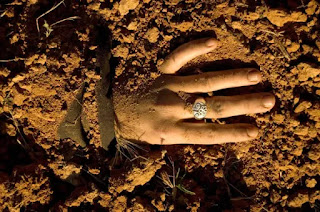A BRIEF HISTORY OF BEING BURIED ALIVE
What happens when you're six feet under with no way out?
Imagine you have a rare disorder, not unlike epilepsy, that causes your heart to slow to a near standstill. Imagine you black out one day and wake up in darkness in a small box, the smell of pine and cement heavy in your nostrils.
You scream, but no one can hear you . You push at the top of the box, but it’s not budging. Your breathing quickens. It slowly dawns on you — you’ve been buried alive.
And you’re far from the first person who this has ever happened to.
The Mummies of Mexico
Like all of the 119 mummies in El Museo de las Mumias, Ignacia Aguilar fell victim to a cholera epidemic that swept Guanajuato, Mexico in 1833. The deceased were buried quickly to prevent the spread of disease in above ground mausoleums.
Twenty years later, the local government disinterred some of the bodies and discovered they’d been naturally mummified. Today, the mummies are on display in the dimly lit museum’s glass cases, where they stand upright against a wall.
But the story of one mummy, named Ignacia, is terrifying. Her hands are balled together above her heart. Her left elbow points downward. At first glance, her head appears to be resting on her elevated right arm.
Upon closer inspection, Ignacia’s teeth are dug into the forearm. Fingernail scratches run jagged in all directions across her forehead, and what little of her mouth is visible beneath the right arm is caked with dried blood. Her body was discovered face down in its coffin. No doubt about it. Ignacia Aguilar was buried alive.
Scientists speculate the average person can survive between one and 18 hours in a modern coffin, depending on body size.
Records indicate that Ignacia was epileptic and suffered from a rare concurrent disorder that lowered her heart rate so much it seemed not to beat at all. Imagine the young girl waking up, caught between a limited air supply and eternity amidst the scent of pine and cement.
Scientists speculate the average person can survive between one and 18 hours in a modern coffin, depending on body size. It’s impossible to guess how long tiny Ignacia in a 19th century mausoleum held out. However long it took, it’s difficult to fathom a worse way to go. Perhaps being flayed by Soviet infantry.
Live Burial as Punishment
Since antiquity, premature burial has been employed as a means of capital punishment in various nations. In ancient Rome, Vestal Virgins who broke their vows of celibacy were immured in small caves. Ditto for rapists of virgins.
In Middle Age Germany, live burial was reserved for women who committed infanticide. In medieval Italy, remorseless murderers were buried alive, headfirst, with their feet sticking above ground.
Under 13th century Danish law, live burial was the execution of choice for female thieves. Male thieves were beheaded, which is, of course, preferable.
Women who killed their husbands in feudal Russia were buried alive in a sacred killing site known as The Pit. It’s said that the Druid St. Oran offered to be buried alive as a sacrifice in order to banish the devil from meddling with the construction of a new abbey.
Sometime later, his still-living body was dug up, but when Oran spoke of visiting an afterlife without heaven or hell, he was reburied for good.
There are numerous modern examples of mass live burials during wartime. Japanese soldiers buried Chinese POWs at Nanking. Nazis interred shtetl elders in Belarus and Ukraine. In the Killing Fields. During the Great Leap Forward. Last year, ISIS militants buried groups of Yazidi women and children alive in Iraq.
Horrible deaths all. But something about the accidental premature burial strikes even greater terror, perhaps because it’s an equal opportunity killer. It renders one utterly powerless, and features the element of surprise.
The occasional incident of a breathing body tumbling from a coffin dropped by some hapless pallbearer, or a screaming corpse on the embalming table, put some degree of fear concerning premature burial into the ether since at least the 1st century A.D. The only notable recorded case prior to the 19th century was philosopher John Duns Scotus, whose body was found outside his coffin upon the reopening of his tomb.
However, beginning in the late 18th century, the fear became more widespread and peaked in the 1890’s, when Italian psychiatrist Enrico Morselli gave it a name: Taphephobia.
George Washington willed that his body was not to be buried for two days following his death, just in case. A group of Victorians organized The Society for the Prevention of People Being Buried Alive in 1896. A number of “safety coffins” were invented in the l880’s.
One, patented in 1882 by U.S. inventor J.G. Krichbaum, featured a periscope that could be opened from within the coffin in order to supply air and signal that an error had been made. In 1885, The New York Times reported that one “Jenkins” of Buncombe County was discovered turned on his side in his coffin, and all of his hair was ripped from his scalp.




.jpg)

.jpeg)






Comments
Post a Comment